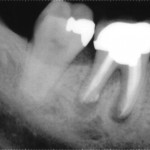
There are a number of ways in which the dental pulp communicates with the periodontium, apical foramina, lateral and accessory canals or exposed dentinal tubules. Consequently periodontal-endodontic lesions can develop and although several classification systems exist this is still an area for debate and a challenge to treat. The aim of this review was to identify and evaluate treatment options for combined periodontal-endodontic lesions.
Searches were conducted in Medline, Embase and the www.opengrey.eu databases. Handsearches of the Journal of Clinical Periodontology, Journal of Periodontology, Journal of Endodontics and International Endodontic Journal were also carried out. Studies where a combined periodontal-endodontic lesion defined as the co-existence of a negative or altered pulp vitality test and PPD ≥6 mm on at least one tooth site in case reports or a mean probing pocket depth ≥6 mm in interventional studies and case series with a follow up period of at least six months were considered. Primary outcome measures were tooth loss, probing pocket depth (PPD), probing attachment level (PAL), gingival recession (REC). Screening was conducted by two reviewers and reviewed by a third. Risk of bias was assessed.
- One randomized controlled clinical trial, two prospective and two retrospective case series, and 18 case reports were included.
- There was considerable heterogeneity in the studies and a narrative synthesis is provided.
- In all publications, a non-surgical root canal treatment (RoCT) was performed as initial treatment step (111 teeth). In 2 case series a two-stage RoCT with temporary intracanal medication was used.
- Non-surgical and/or a surgical periodontal therapy was applied in some studies without re-evaluation of the endodontic healing. Probing pocket depth reductions were reported in all included studies, comprising the data from 80 teeth at follow-up.
The authors concluded
This review may provide some evidence for root canal treatment as a first treatment step for the treatment of combined periodontal-endodontic lesions with increased PPD and a negative response of pulp sensibility testing. A reasonable time for healing of the endodontic lesion after root canal treatment is suggested to consider before further therapy is applied.
Comment
As the authors note the search strategy was limited to English, which means that some potentially relevant studies could have been missed. The studies that have been identified are mainly case series or retrospective and more likely to suffer from bias. Consequently there is little good evidence for the best approaches for the treatment of combined periodontal-endodontic lesions.
Links
Schmidt JC, Walter C, Amato M, Weiger R. Treatment of periodontal-endodontic lesions – a systematic review. J Clin Periodontol. 2014 Aug;41(8):779-90. doi: 10.1111/jcpe.12265. Epub 2014 Jul 2. PubMed PMID: 24766568.


@TheDentalElf ” few” as in very few or “a” few as in better than usual.. ?
There is little good evidence for best approach to management of perio-endo lesions http://t.co/OABtTW5xyU
New systematic review only finds 3 prospective studies that examine the treatment of perio-endo lesions http://t.co/zriIgXPsvi
Don’t miss: Review found very few good quality studies on the treatment of combined periodontal-endodontic lesions http://t.co/JYaC2o4wxB